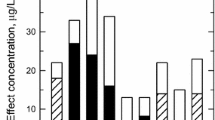Abstract
Four groups of 22 to 24 sandworms,Nereis virens, were maintained in closed aquarium systems with continuous charcoal filtration and 45 L capacity at 20% salinity and 4, 8, 12, and 16°C. The worms of 2.0 to 5.4 g initial wet weight inhabiting glass tubes were given 10 oral doses of 0.3μg 2,4,6,2′,4′-pentachloro[U-14C]biphenyl (PCB) during 10 consecutive days and were subsequently allowed to eliminate the compound for up to 45 weeks. Consumption and accumulation averaged 80.9, 78.3, 73.5, and 68.4% at the four temperatures. The elimination may be described with an exponential function and was fastest at 12°C. For instance, the times of initial 30% decrease te30 were 18.7, 16.8, 5.3, and 8.0 weeks at 4, 8, 12, and 16°C. Forty to 45% of the eliminated PCB were recovered from the feces, and the amounts from the feces confirmed the optimum PCB elimination at 12°C. The elimination optimum at submaximum temperatures suggests that PCB elimination byNereis virens, at least in part, is an active process. By comparison with earlier work, a dependence of the elimination times te30 or te50 on initial concentration was found thus favoring a multicompartment elimination model. Unequal PCB contents of anterior and posterior worm parts were governed by unequal lipid contents.
Similar content being viewed by others
References
Bruggeman WA, Martron LBJM, Kooiman D, Hutzinger O (1981) Accumulation and elimination kinetics of di-, tri- and tetrachlorobiphenyls by goldfish after dietary and aqueous exposure. Chemosphere 10:811–832
Calambokidis J, Mowrer J, Beug MW, Herman SG (1979) Selective retention of polychlorinated biphenyl components in the mussel,Mytilus edulis. Arch Environ Contam Toxicol 8:299–309
Edgren M, Olsson M, Renberg L (1979) Preliminary results on uptake and elimination at different temperatures ofp,p′-DDT and two chlorobiphenyls in perch from brackish water. Ambio 8:270–272
Ernst W (1979) Factors affecting the evaluation of chemicals in laboratory experiments using marine organisms. Ecotoxicol Environ Safety 3:90–98
Ernst W, Goerke H, Weber K (1977) Fate of14C-labelled di-, tri- and pentachlorobiphenyl in the marine annelidNereis virens. II. Degradation and faecal elimination. Chemosphere 6:559–568
Ernst W, Schaefer RG, Goerke H, Eder G (1974) Aufarbeitung von Meerestieren für die Bestimmung von PCB, DDT, DDE, DDD, γ-HCH und HCB. Z Analyt Chem 272;358–363
Fowler SW, Polikarpov GG, Elder DL, Parsi P, Villeneuve J-P (1978) Polychlorinated biphenyls: accumulation from contaminated sediments and water by the polychaeteNereis diversicolor. Mar Biol 48:303–309
Goerke H (1979)Nereis virens (Polychaeta) in marine pollution research: culture methods and oral administration of a polychlorinated biphenyl. Veröff Inst Meeresforsch Bremerh 17:151–161
Goerke H, Ernst W (1977) Fate of14C-labelled di-, tri- and pentachlorobiphenyls in the marine annelidNereis virens. I. Accumulation and elimination after oral administration. Chemosphere 6:551–558
— (1980) Accumulation and elimination of14C-γ-HCH (lindane) inNereis virens (Polychaeta) with consideration of metabolites. Helgoländer Meeresunters 33:313–326
Guiney PD, Melancon MJ Jr, Lech JJ, Peterson RE (1979) Effects of egg and sperm maturation and spawning on the distribution and elimination of a polychlorinated biphenyl in rainbow trout (Salmo gairdneri). Toxicol Appl Pharmacol 47:261–272
Guiney PD, Peterson RE (1980) Distribution and elimination of a polychlorinated biphenyl after acute dietary exposure in yellow perch and rainbow trout. Arch Environ Contam Toxicol 9:667–674
Guiney PD, Peterson RE, Melancon MJ Jr, Lech JJ (1977) The distribution and elimination of 2,5,2′,5′-[14C]tetrachlorobiphenyl in rainbow troutSalmo gairdneri). Toxicol Appl Pharmacol 39:329–338
Hansen DJ, Parrish PR, Lowe JI, Wilson AJ Jr, Wilson PD (1971) Chronic toxicity, uptake and retention of Aroclor® 1254 in two estuarine fishes. Bull Environ Contam Toxicol 6:113–119
Hattula ML, Karlog O (1973) Absorption and elimination of polychlorinated biphenyls (PCB) in goldfish. Acta Pharmacol Toxicol 32:237–245
Landrum PF (1982) Uptake, depuration and biotransformation of anthracene by the scudPontoporeia hoyi. Chemosphere 11:1049–1057
Langsten WJ (1978) Persistence of polychlorinated biphenyls in marine bivalves. Mar Biol 46:35–40
Lowe JI, Parrish PR, Patrick JM Jr, Forester J (1972) Effects of the polychlorinated biphenyl Aroclor 1254 on the American oysterCrassostrea virginica. Mar Biol 17:209–214
McLeese DW, Metcalfe CD, Pezzack DS (1980) Uptake of PCBs from sediment byNereis virens andCrangon septemspinosa. Arch Environ Contam Toxicol 9:507–518
Author information
Authors and Affiliations
Rights and permissions
About this article
Cite this article
Goerke, H. Temperature-dependent elimination of 2,4,6,2′, 4′-pentachloro[U-14C]biphenyl inNereis virens (Polychaeta). Arch. Environ. Contam. Toxicol. 13, 347–355 (1984). https://doi.org/10.1007/BF01055286
Received:
Revised:
Issue Date:
DOI: https://doi.org/10.1007/BF01055286




